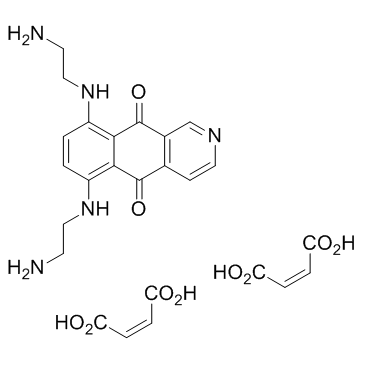
Pixantrone dimaleate
CAS No. 144675-97-8
Pixantrone dimaleate( BBR 2778 )
Catalog No. M11902 CAS No. 144675-97-8
Pixantrone dimaleate (BBR 2778 dimaleate) is an experimental antineoplastic drug.
Purity : >98% (HPLC)
 COA
COA
 Datasheet
Datasheet
 HNMR
HNMR
 HPLC
HPLC
 MSDS
MSDS
 Handing Instructions
Handing Instructions
| Size | Price / USD | Stock | Quantity |
| 5MG | 42 | In Stock |


|
| 10MG | 65 | In Stock |


|
| 25MG | 120 | In Stock |


|
| 50MG | 205 | In Stock |


|
| 100MG | 312 | In Stock |


|
| 500MG | 743 | In Stock |


|
| 1G | Get Quote | In Stock |


|
Biological Information
-
Product NamePixantrone dimaleate
-
NoteResearch use only, not for human use.
-
Brief DescriptionPixantrone dimaleate (BBR 2778 dimaleate) is an experimental antineoplastic drug.
-
DescriptionPixantrone dimaleate (BBR 2778 dimaleate) is an experimental antineoplastic drug.(In Vitro):Pixantrone (0-10 μM, 72 h) dimaleate induces cell death in multiple cancer cell lines independent of cell cycle perturbation, with IC50s of 37.3 nM, 126 nM and 136 nM for T47D, MCF-10A and OVCAR5 cells, respectively.Pixantrone (25-500 nM, 2 4 h) dimaleate induces DNA damage at high concentration of 500 nM and induces severe chromosomal aberrations and mitotic catastrophe in PANC1 cells.Pixantrone (100 nM, 24 h) dimaleate may disrupt chromosome segregation because of generating merotelic kinetochore attachments that cause chromosome non-disjunction.Pixantrone (0-100 μM, 72 h) dimaleate potently inhibits growth of human leukemia K562 cells, etoposide-resistant K/VP.5 cells, MDCK and ABCB1-transfected MDCK/MDR cells with IC50s of 0.10 μM, 0.56 μM, 0.058 μM and 4.5 μM, respectively.Pixantrone (0.01-0.2 μM) dimaleate leads to a concentration-dependent formation of linear DNA through acting on topoisomerase Iiα and produces semiquinone free radicals in an enzymatic reducing system, although not in a cellular system, most likely due to low cellular uptake.Pixantrone (0.01-10 μM) dimaleate shows potent inhibitory activities against rat 97-116 peptide-specific T cell proliferation.(In Vivo):Pixantrone (i.v., 27 mg/kg, every 7 days, three times) dimaleate does not worsen pre-existing moderate degenerative cardiomyopathy, causes minimal cardiotoxic in mice following repeated treatment cycles and results in less mortality than mitoxantrone in doxorubicin-pretreated mice.Pixantrone (i.v., 16.25 mg/kg, every week, three times) dimaleate modulates Lymph node cells (LNC) responses, affacts T cell subpopulations in TAChR-immunized Lewis rats and also shows preventive and therapeutic effect in experimental autoimmune myasthenia gravis (EAMG) rats.
-
In Vitro——
-
In Vivo——
-
SynonymsBBR 2778
-
PathwayOthers
-
TargetOther Targets
-
RecptorOthers
-
Research AreaCancer
-
Indication——
Chemical Information
-
CAS Number144675-97-8
-
Formula Weight557.21
-
Molecular FormulaC25H27N5O10
-
Purity>98% (HPLC)
-
SolubilityDMSO: 10 mM
-
SMILESC1=CC(=C2C(=O)C3=C(C(=O)C2=C1NCCN)C=CN=C3)NCCN.C(=C\C(=O)O)\C(=O)O.C(=C\C(=O)O)\C(=O)O
-
Chemical Name——
Shipping & Storage Information
-
Storage(-20℃)
-
ShippingWith Ice Pack
-
Stability≥ 2 years
Reference
1.Cavalletti E., et al. Invest New Drugs, 2007. 25(3): p. 187-95.
molnova catalog



related products
-
Dehydroacetic acid
Dehydroacetic acid is an organic compound, classified as a pyrone derivative and is used mostly as a fungicide and bactericide.
-
HIV-1 TAT 48-60
HIV-1 TAT (48-60) is a cell-penetrating peptide derived from the human immunodeficient virus (HIV)-1 Tat protein residue 48-60. This is one of the cell-penetrating peptides generated from the human immunodeficient virus -1 Tat protein residue 48-60.
-
Elamipretide 2TFA
Elamipretide is a novel mitochondrion-targeted antioxidant.?Treatment with elamipretide significantly ameliorated LPS-induced learning and memory impairment during behavioral tests.



 Cart
Cart
 sales@molnova.com
sales@molnova.com


